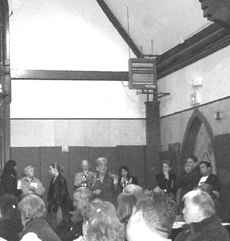Details Still Hazy as Trustees Approve $91.5 Million for UMB Dorms

City Councillor Maureen Feeney addresses a concerned Columbia Savin Hill Civic Association.
August 15, 2002
On July 24, the long-awaited results of Sasaki Associates’ feasibility study finally arrived at the university. However, it could take over a month before the next big steps in the dorms project are underway.
Chancellor Jo Ann Gora was on vacation when the results came in, so she didn’t receive the report until August 5. Although The Mass Media has not been able to obtain a copy of the results yet, we have received some information regarding the contents of the report. The Watertown-based consulting firm has found that some of the proposed sites for housing are actually feasible to build on. In a preliminary report to faculty and staff in April, representatives from Sasaki discussed eight sites. In the most recent draft of their feasibility findings the consulting firm have narrowed it down to three sites on which it would actually make sense for the university to use as grounds for dorms. “The three sites they have selected are the feasible ones,” said Director of University Communications, Anne Marie Lewis-Kerwin.
One of the sites found suitable to build on is the current home of “Huru,” the large metal sculpture which was the first acquisition of the “Arts on the Point” project. The site extends to where the university currently has a soccer field.
Lewis-Kerwin assured The Mass Media that “anything they take away they’ll replace.” But that could lead to a constant shifting and re-shifting of the layout of the Point resembling a giant game of Tetris.
For instance, if dorms are placed in the area currently occupied by the soccer field, where would the new field go?
The most likely area for a new soccer field is behind the Clark Athletic Center, the current site of several parking spaces. If those parking spaces are eliminated, where will they be rebuilt? And so on. Parking is a major concern associated with the new dormitories. “We have to have more discussion on the parking issue,” Lewis-Kearwin admitted.
Another site proposed as feasible for housing is adjacent to the new Campus Center, currently a parking lot. For students who live on-campus, proximity to that center will be practically vital, but for the students still commuting by car, the parking will be even tighter.
According to Lewis-Kerwin the report holds schematic designs for the three phases of construction, and there are three different building designs posed for each of the sites.
One important part of the report is still missing. The breakdown of the actual cost to the university for each phase proposal. “That part of the report we are still waiting for,” said Lewis-Kerwin.
The UMass Board of Trustees has approved $91.5 million for the the dorms project on Columbia Point. That money is for the first phase and will most likely be supplemented by state funds. Another $131 million was pledged toward the other two phases of the 2,000 bed plan, projected for completion in 2012. The tentative timetables for the three phases are: Phase One, 2003-2007, and Phases Two and Three, 2008-2012. But, just because the board has voted on this project, doesn’t mean it’s a done deal.
Chancellor Gora, in an e-mail discussing the funding approval by the Board of Trustees stated, “This is good news but it does NOT mean we [the university] have ‘the money.’ It means we have the authorization to borrow the money.” The Chancellor went on to say that coverage of the board’s decision in the press may have been misleading. “The dorms will be funded through bonds, not tuition, not fees, not state funds. The folks living in the dorms will be paying the debt service on the bonds and that is how we are able to finance this major construction.”
This Sasaki study is only a draft report. There will be several meetings held over the next few weeks to discuss the findings and submit changes to Sasaki. Then UMass Boston has to settle a promise made to the surrounding community earlier this year.
In April, at a Columbia Savin Hill Civic Association Meeting, representatives from the university announced their intention to conduct a Community Impact Study. The Community Impact Study could take up to six months to complete. Lewis-Kerwin is hopeful that it will at least be underway by the end of September.
The university’s board of trustees made a promise in 1973 that the campus at Boston would remain a commuter institution to minimize the student housing impact on the Dorchester community. With studies underway and funding plans in place, that promise will most definitely be broken.
Residents in the areas surrounding the university have repeatedly expressed concern that adding a housing component to UMass Boston could exacerbate housing pressures in their neighborhoods. Other college-heavy areas of Boston have seen similar trends occur. Think Allston-Brighton.
Lewis-Kerwin insists that because the university is “not looking to buy up housing stock to house students,” the student population in the Dorchester community will not drastically increase.
But, even if the university is not directly involved in placing students into the neighborhoods surrounding the Harbor Campus, dorms may do just that. When students reach their junior and senior years, they may get tired of the dorm scene but be used to being close to the university. If that happens the community may absorb that overflow student population.
The Boston Globe reported that the groundbreaking for the dorms project could happen as early as 2003. “It may happen, it may not happen,” Lewis-Kerwin responded when asked if that date was set. She was quoted in The Boston Globe as saying, “If there are no issues, the university would like to break ground in the summer of 2003.”





















































